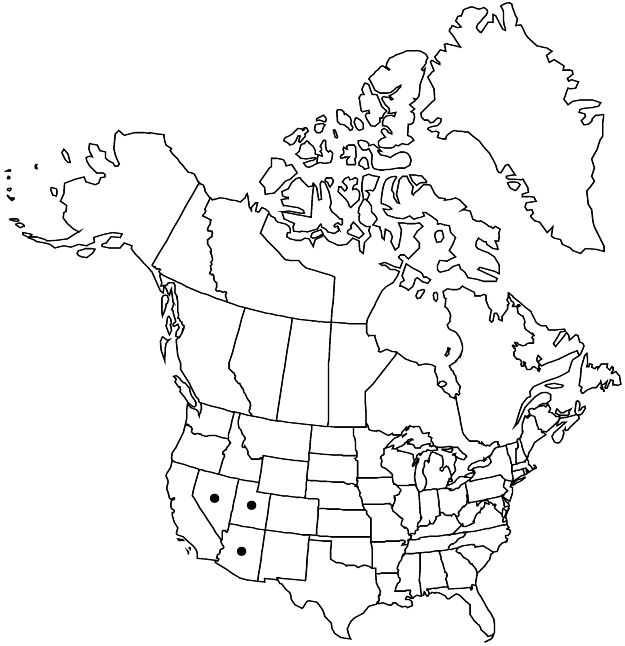Difference between revisions of "Glossopetalon spinescens var. microphyllum"
Brittonia 40: 272, fig. 1i – l. 1988.
FNA>Volume Importer |
imported>Volume Importer |
||
| (4 intermediate revisions by 2 users not shown) | |||
| Line 27: | Line 27: | ||
|elevation=1300–2400 m | |elevation=1300–2400 m | ||
|distribution=Ariz.;Nev.;Utah. | |distribution=Ariz.;Nev.;Utah. | ||
| − | |discussion=<p>A single collection from San Bernardino County, California (Davidson, Gustafson & Reynolds 7853 [MO, RSA]), compares well with specimens from the main range of < | + | |discussion=<p>A single collection from San Bernardino County, California (Davidson, Gustafson & Reynolds 7853 [MO, RSA]), compares well with specimens from the main range of <i></i>var.<i> microphyllum</i> in its small leaves, divaricate branching, and orangish brown older branchlets, but appears to differ in being a somewhat taller plant with the twigs changing color more tardily and the leaves moderately puberulent (versus glabrous) abaxially. Further studies may confirm a disjunct range extension for this variety in eastern California.</p> |
|tables= | |tables= | ||
|references= | |references= | ||
| Line 36: | Line 36: | ||
-->{{#Taxon: | -->{{#Taxon: | ||
name=Glossopetalon spinescens var. microphyllum | name=Glossopetalon spinescens var. microphyllum | ||
| − | |||
|authority=N. H. Holmgren | |authority=N. H. Holmgren | ||
|rank=variety | |rank=variety | ||
| Line 51: | Line 50: | ||
|publication year=1988 | |publication year=1988 | ||
|special status=Endemic | |special status=Endemic | ||
| − | |source xml=https:// | + | |source xml=https://bitbucket.org/aafc-mbb/fna-data-curation/src/2e0870ddd59836b60bcf96646a41e87ea5a5943a/coarse_grained_fna_xml/V9/V9_23.xml |
|genus=Glossopetalon | |genus=Glossopetalon | ||
|species=Glossopetalon spinescens | |species=Glossopetalon spinescens | ||
Latest revision as of 22:55, 5 November 2020
Shrubs, 25–60 cm. Branchlets divaricate to ± ascending, usually turning from grayish green to dull orangish brown toward end of 1st year, (sometimes later), glabrous or ciliolate. Leaves usually well developed at flowering, sometimes early deciduous, branches sometimes appearing nearly leafless later in growing season; stipules present, sometimes difficult to observe, adnate portion dark reddish purple to nearly black, usually well developed, noticeably thickened, free portion usually relatively well developed, mostly narrowly triangular to subulate, 0.4–1.2 mm; largest blade 3–7(–8) × 1.2–2.7 mm, margins glabrous or ciliolate, glabrous. Petals 4–8 mm, mostly widest proximal to apex sometimes nearly oblong, apex rounded to gradually acute or acuminate, tips blunt or sharply pointed. Stamens 6–10 in 2 unequal series.
Phenology: Flowering Apr–Jun.
Habitat: Rocky margins of washes, steep rocky hillsides, crevices and ledges of cliffs and outcrops, mostly on limestone substrates
Elevation: 1300–2400 m
Distribution

Ariz., Nev., Utah.
Discussion
A single collection from San Bernardino County, California (Davidson, Gustafson & Reynolds 7853 [MO, RSA]), compares well with specimens from the main range of var. microphyllum in its small leaves, divaricate branching, and orangish brown older branchlets, but appears to differ in being a somewhat taller plant with the twigs changing color more tardily and the leaves moderately puberulent (versus glabrous) abaxially. Further studies may confirm a disjunct range extension for this variety in eastern California.
Selected References
None.